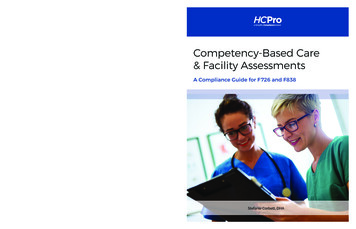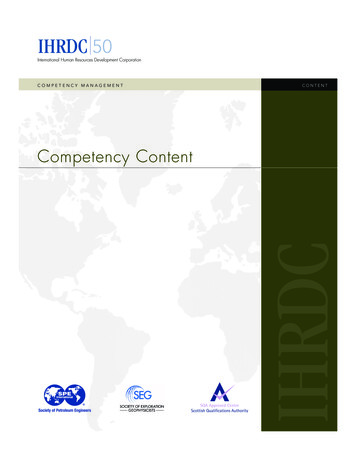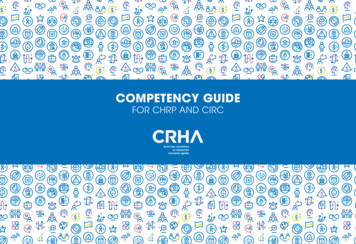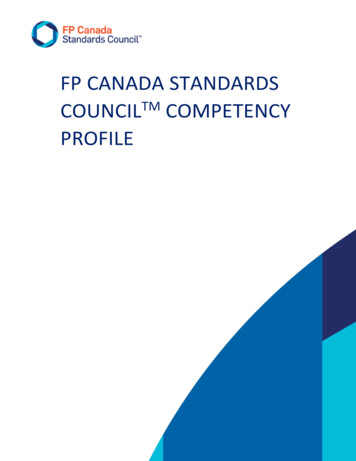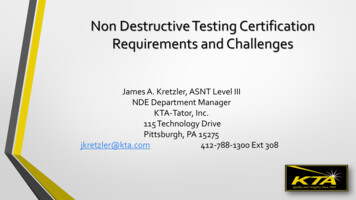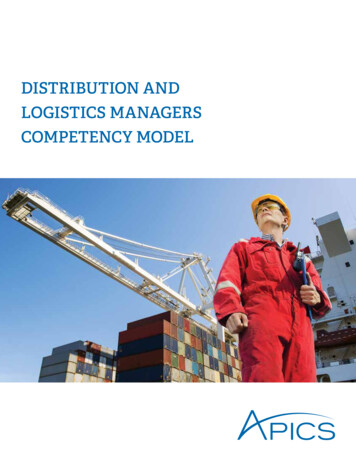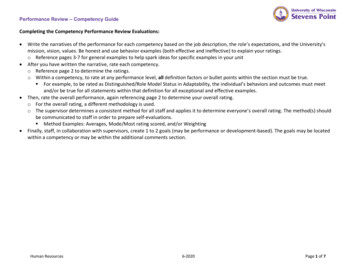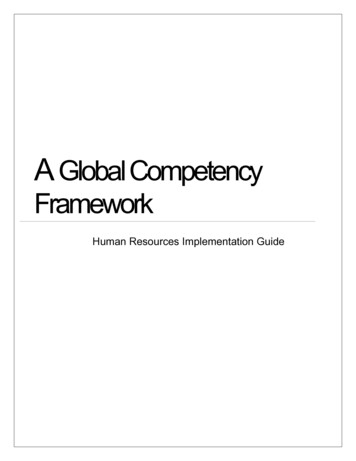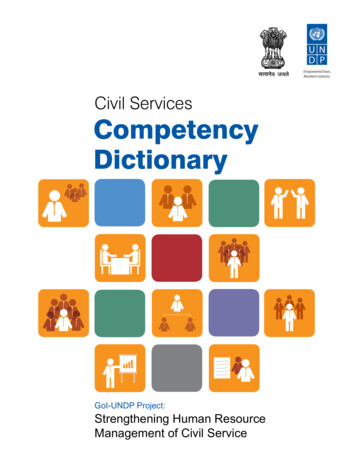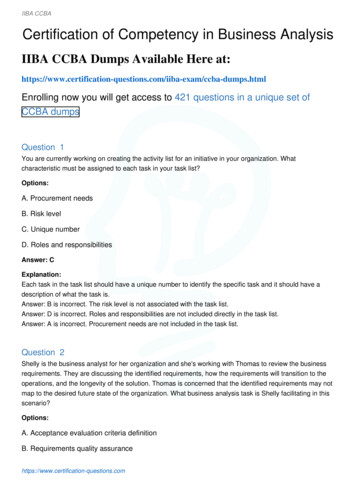
Transcription
IIBA CCBACertification of Competency in Business AnalysisIIBA CCBA Dumps Available Here am/ccba-dumps.htmlEnrolling now you will get access to 421 questions in a unique set ofCCBA dumpsQuestion 1You are currently working on creating the activity list for an initiative in your organization. Whatcharacteristic must be assigned to each task in your task list?Options:A. Procurement needsB. Risk levelC. Unique numberD. Roles and responsibilitiesAnswer: CExplanation:Each task in the task list should have a unique number to identify the specific task and it should have adescription of what the task is.Answer: B is incorrect. The risk level is not associated with the task list.Answer: D is incorrect. Roles and responsibilities are not included directly in the task list.Answer: A is incorrect. Procurement needs are not included in the task list.Question 2Shelly is the business analyst for her organization and she's working with Thomas to review the businessrequirements. They are discussing the identified requirements, how the requirements will transition to theoperations, and the longevity of the solution. Thomas is concerned that the identified requirements may notmap to the desired future state of the organization. What business analysis task is Shelly facilitating in thisscenario?Options:A. Acceptance evaluation criteria definitionB. Requirements quality assurancehttps://www.certification-questions.com
IIBA CCBAC. Validate requirementsD. Stakeholder managementAnswer: CExplanation:Shelly and Thomas are performing the validate requirements task. This task helps to ensure that therequirements map to the business goals and objectives, resolve the issue, and predict the longevity of therequirements to satisfy business needs.Answer: B is incorrect. There is not a business analysis task called requirements quality assurance.Answer: A is incorrect. Acceptance evaluation criteria definition is a task to ensure that the requirementsare clear and precise enough to create tests and inspect to know that the work has been completed.Answer: D is incorrect. Stakeholder management is the management of stakeholders' issues, conflicts,queries, concerns, threats, and perceived threats about the requirements.Question 3Which of the following are documented approaches to the business analysis work? Each correct answerrepresents a complete solution.Options:A. Deming's Quality CircleB. LeanC. Six SigmaD. Waterfall approachAnswer: B, C, DExplanation:The waterfall approach, lean, and Six Sigma are the valid answer for business analysis approaches.Answer: A is incorrect. Deming's Quality Circle describes the quality management approach of plan, do,check, and act. This isn't a business analysis approach.Question 4Tracy is a business analyst for her organization and she's gathered and identified the needed requirementsfor the solution scope. What must Tracy do before she can begin managing the requirements? Choose thebest answer.Options:A. Tracy must decompose the requirements in WBS.B. Tracy must create cost-benefits analysis of each requirement to manage the benefits first.https://www.certification-questions.com
IIBA CCBAC. Tracy must identify roles, responsibilities, and owners of the requirements to fully manage therequirements.D. Tracy must communicate the requirements to the stakeholders for their consent and approval.Answer: DExplanation:Requirements must be communicated before they are managed. Tracy must communicate therequirements to the stakeholders for their consent and approval before managing the requirements.Answer: A is incorrect. Before Tracy decomposes the requirements, she should have the approval of thestakeholders.Answer: B is incorrect. To begin managing the requirements, Tracy needs the approval and consent of thestakeholders.Answer: C is incorrect. This isn't a valid statement, as the best thing to do is to gain the approval of thestakeholders first.Question 5Ben is the business analyst for his organization. Ben is currently working on a solution to improve a laserprinter. He has taken the laser printer apart, identified each component, and documented eachcomponent's purpose. What type of requirements organization is Ben doing in this scenario?Options:A. Functional decompositionB. Process modelingC. Scope modelingD. Data modelingAnswer: AExplanation:Ben is completing the functional decomposition technique for the organize requirements process. Eachcomponent in the printer can have its own set of requirements, while the improved printer to bemanufactured is the ultimate goal of the requirements.Answer: D is incorrect. Data modeling describes the concepts and relationships relevant to the solution orbusiness domain.Answer: C is incorrect. Scope modeling allows the requirements to be organized by the solution componentthey're relevant to.Answer: B is incorrect. Process modeling is the activity of representing processes of an enterprise, so thatthe current process may be analyzed and improved in future. It allows the requirements to be organizedaround the related processes. Processes are also considered to have sub-processes, inputs, and outputs.https://www.certification-questions.com
IIBA CCBAQuestion 6You are the business analyst for your organization and you're working with Fran on business analysisprocesses. Fran is a stakeholder who wants to ensure that your business analysis approach and activitiesare compatible with the project activities. Of the following, what type of business analysis stakeholder isFran?Options:A. RegulatorB. Project managerC. SponsorD. Domain subject matter expertAnswer: BExplanation:Fran is the project manager. The project manager must ensure that the business analysis approach iscompatible with other project activities.Answer: D is incorrect. The domain subject matter expert is a person who is steeped in knowledgeregarding the project's purpose.Answer: A is incorrect. The regulator approves any tailoring to the business analysis processes or activities.Answer: C is incorrect. The sponsor allows the business analysis activities and resources to exist in supportof the organization.Question 7You are a business analyst for your organization and you're working with Mary. Mary wants to know whatyou need to complete the process of planning the business analysis approach if you're already thebusinessanalyst for your organization. Which of the following statements is true regarding the plan business analysisapproach?Options:A. The plan business analysis approach describes the amount of budget needed for therequirementselicitation.B. The plan business analysis approach is required to select an approach that will performbusinessanalysis.C. The plan business analysis approach describes the processes the business analyst will or willnot do,based on the time and budget available.https://www.certification-questions.com
IIBA CCBAD. The plan business analysis approach describes the amount of time needed for the businessanalysisapproach.Answer: BExplanation:The plan business analysis approach is required to select an approach that will perform business analysis.This approach helps to find out the following:Which stakeholders need to be involved in the decision?Who will be consulted regarding and informed of the approach?What is the rationale for using it?Answer: D, A, and C are incorrect. These statements are not true regarding the plan business analysisapproach.Question 8You are the business analyst for a large software development project. There are several issues that mustbe resolved by certain dates or the problem will prevent the project from advancing. What technique canyou use to track problems with the requirements?Options:A. Issue trackingB. RTMC. Problem trackingD. BaseliningAnswer: CExplanation:The technique you'll use is simply problem tracking. This technique allows the business analyst to manageany issues identified within requirements by stakeholders and to ensure that those issues are resolved.Problem tracking allows the business analyst to manage any issues identified within requirements bystakeholders and to ensure that those issues are resolved. It provides an organized approach to tracking,management, and resolution of defects, issues, problems, and risks throughout business analysis activities.Management of issues is important so that they can be resolved in a timely manner to ensure success.Answer: D is incorrect. Baselining the requirements does not track problems but creates a standard set ofrequirements that deliverables may be compared against.Answer: A is incorrect. Issue tracking is not a valid business analysis term.Answer: B is incorrect. An RTM is a requirements trace matrix which tracks requirements through thesolution, not issues.Question 9https://www.certification-questions.com
IIBA CCBAWhich one of the following statements is most true about changing requirements in a change-drivenapproach to business analysis and requirements management?Options:A. Change-driven approaches must use a change control system with a change control board.B. Change-driven approaches only use a change control system for approved changes.C. Change-driven approaches don't use a formal change control process.D. Change-driven approaches are driven by change control processes.Answer: CExplanation:Change-driven approaches typically do not use a formal change control process, as requirements areprioritized and selected for implementation at the beginning of each iteration and no changes to therequirements occur during the iteration process.Answer: A is incorrect. Change-driven approaches don't typically use a change control board.Answer: B is incorrect. This isn't a valid statement to describe the processes of change within a changedriven approach to requirements management.Answer: D is incorrect. This isn't a valid statement to describe the processes of change within a changedriven approach to requirements management.Question 10You are the business analyst for your organization and working with the stakeholders to prioritize therequirements. The stakeholders are concerned about the financial impact of the requirements should someof them fail during the implementation. You would like to rank the risk tolerance of the stakeholders basedon their comments about the solution and the requirements. The following are the three categories of risktolerance associated with the stakeholders except for which one?Options:A. NeutralityB. MitigationC. Risk-seekingD. Risk-aversionAnswer: BExplanation:Mitigation is a risk response that seeks to lower the risk's probability and/or impact. It is not one of the threecategories of risk tolerance.Would you like to see more? Don't miss our CCBA PDFhttps://www.certification-questions.com
IIBA CCBAfile .com
D. The plan business analysis approach describes the amount of time needed for the business analysis approach. Answer: B Explanation: The plan business analysis approach is required to select an approach that will perform business analysis.

